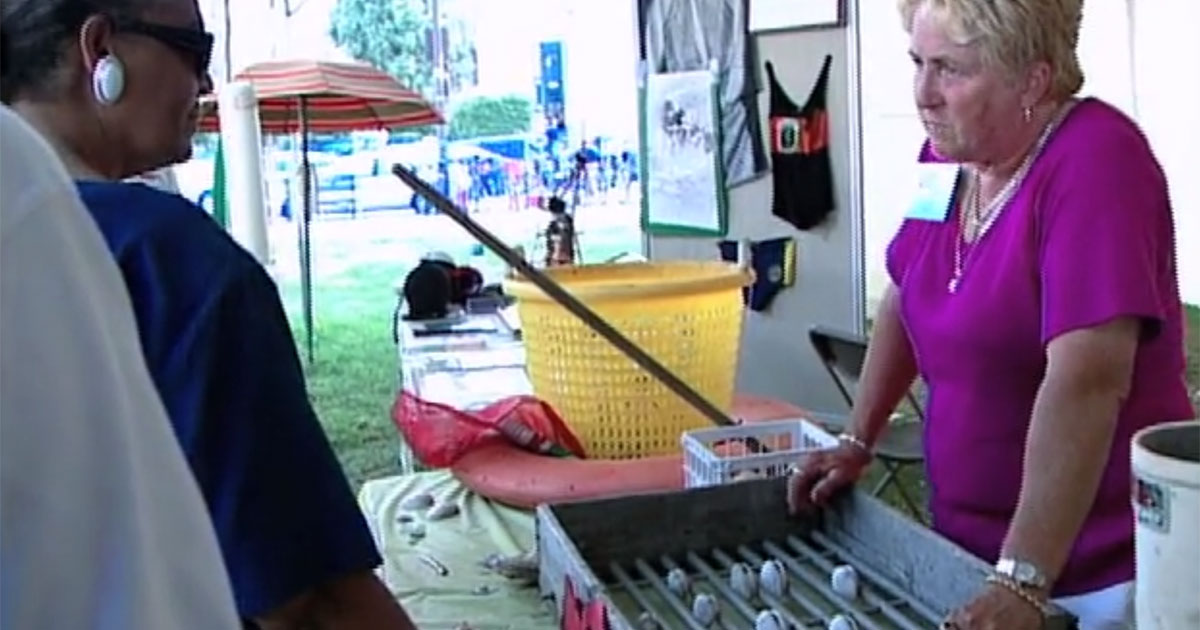









Fishing With Pots:
Crabs, Conch and Eels
Hard crabs, conch and eels are caught with pots, or traps, of various types in the Mid-Atlantic. The fish are lured into the pots with bait including horseshoe crabs for eels and conch and menhaden for crabs. Crab pots, usually measuring two feet square and made from chicken wire, are now used by more fishermen than the older method of "trot" lining (a line of baited hooks). In Lewes, Delaware, conch pots are made from large plastic pickle barrels. Tube-shaped eel pots were traditionally made of wood by local craftsmen but are now more often made of cloth or metal and purchased from fishing suppliers.
For women, the business of making crab and eel pots at home is often compatible with raising a family. Libby Brickhouse from Columbia, North Carolina, has been making crab pots for 25 years. "I can cook while I'm making a crab pot!" she says. Mary Ellen Cox, a crab and eel pot maker from Hyde County, North Carolina, agrees. "When my children were small I had a friend who made crab pots, and she asked if I would like to help her. That way I [could work at home and I] wouldn't have to pay a babysitter.
Fishing with Dredges and Scrapes:
Clams, Oysters, and Soft Crabs
Oyster frye attach themselves to reefs and do not move once they begin growing a shell. Clams burrow into sand or mud. To catch these bivalves, the most efficient tool is a dredge, a large metal basket with teeth dragged along the bottom of a body of water. Similar to a dredge but with a net basket and no teeth, a scrape is used to gather crabs from the bay grasses they hide in for protection when they approach their "peeler" stage and are about to molt their outgrown shells. Dredges have been blamed for major damage to benthic (bottom) habitats and sub-aquatic vegetation. Added to disease, pollution, and other factors, dredging has spelled disaster for oysters and some clam species throughout the Mid-Atlantic region.

Scrapes were patented in 1870 by L. Copper Dize of Crisfield, Maryland. Says Captain Edward Harrison of Smith Island, Maryland, whose crab-scrape boat can navigate in water as shallow as two feet, "Most of the boys have gone to using hydraulics to haul up the [crab] scrape, but I guess I'll keep doing it by hand. I do all right."
Raking and Tonging
Traditionally, clammers used rakes and oyster fishermen used tongs to catch their shellfish. Raking for clams and tonging for oysters is less efficient than dredging but can be done with less manpower and in shallower water. For many years, before large dredging boats like schooners, bugeyes, and skipjacks were introduced, hand tonging for oysters was the only method used in areas like the Chesapeake Bay and its tributaries.

Clammer Florence Sharkey from Patchogue, Long Island, wades into mud flats of the Great South Bay on handmade wooden stilts which attach to her feet and keep her from sinking into the mud. Florence uses a rake that her father designed. She began clamming with her father when she was young, and now she works with her son Paul. "As you get older, you realize the importance of following the tradition of the family," she says. "It's a hard life, it's a fun life, and you have to love it to do it."

